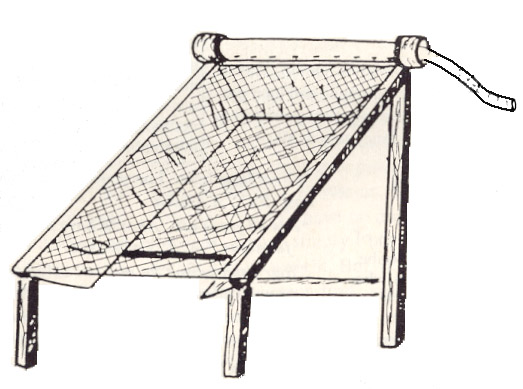By Dave McCracken
Classification is necessary to increase the amount of smaller particles of gold that you will trap in your recovery system.

It takes more water velocity to move larger-sized material than it does to move the smaller-sized material through a sluice box. Yet, to the degree that the water velocity over a sluice box is increased, there may be a loss of fine gold recovery. Or, to the degree the water velocity over a sluice box is slowed down, there is likely to be an increase in fine gold recovery–as long as there is still enough flow over the box to keep the riffles concentrating.
 When larger rocks are pushed through a sluice box by water force, they also create greater turbulence behind the riffles as they pass over, which may cause an additional loss of fine gold.
When larger rocks are pushed through a sluice box by water force, they also create greater turbulence behind the riffles as they pass over, which may cause an additional loss of fine gold.
To improve gold recovery, it is common practice to run material through a screen to classify out the larger rocks before running the material through the recovery-portion of a sluice box. In this way, less water velocity is needed through the box, which allows for a more orderly flow, and an increase in fine gold recovery. The action of screening materials is called “classification.” Materials which have been passed through a classification screen are called “classified materials.” The following video segment demonstrates this very important point:
The size and depth of riffles within a sluice box play an important part of this. A slower water flow might not keep a deeper riffle concentrating. A greater water flow can sometimes “boil-out” a lower-profile riffle. So as water flow is slowed down to catch finer-sized gold, it is generally necessary to use shorter riffles.
Half-inch mesh screen is commonly used for primary classification in small and medium-sized sluicing operations, because the screen is large enough to allow classification to take place quickly, yet no materials greater than half-inch in size will get into the sluice. Therefore a slower-velocity of water can be directed through the box, and fine gold recovery will be improved.
Classification for a sluicing operation can be done in any number of ways. One is to place a piece of strong half-inch mesh screen over a bucket, and shovel or pour through the screen into the bucket while sweeping the larger material off to the side. Once the bucket is filled with classified material, it can be poured into the sluice box at a uniform rate. It is better to not dump the whole bucket into the sluice all at once! This is because too much material is likely to overload the riffles and cause a loss of gold recovery.
In a situation where it is necessary to haul material a short distance to the sluice box, sometimes it is easiest to classify the material directly into a wheelbarrow and transfer only the classified material to the sluice.
Perhaps one of the best screening methods is to build a classification device that you can shovel into, and which will stand directly over the top of, and drop the classified materials into, the head of your sluice box.
The device should be built with the screen set at an angle. This way, larger material is helped to roll off of the screen as the pay-dirt is shoveled onto it. Smaller materials should fall through the screen and be directed into the head of your sluice box. This is actually a miniature model of the big classifiers used by large-scale heavy equipment bench-mining operations. A classification device such as this is rather easy and economical to build and will speed up a production-sluicing operation while screening is being done to improve gold recovery.
Any recovery system will only recover gold effectively down to a certain size-range. Most gold particles smaller in size than that will be lost with the tailings. Classification is one effective way of increasing the amount of gold that will be recovered out of the material that will be processed. As demonstrated in this following video segment, this is especially true of suction dredges; because dredges are able to increase the volume of production over other types of hand-mining activity.
Here is a substantial explanation of the system which we have developed to effectively recover more fine gold on our conventional suction dredges. It combines two classification screens to more-effectively separate material-feed into three size-fractions, each which is directed into a different recovery system. The smallest gold particles (which are most difficult to recover) are directed into low-profile riffles along the bottom of the sluice box which have long been proven to be very effective at trapping fine gold.
- Here is where you can buy a sample of natural gold.
- Here is where you can buy Gold Prospecting Equipment & Supplies.
- More About Sluicing
- Setting The Proper Water Velocity Through a Sluice Box
- Setting Up the Proper Recovery System
- Gold Mining Adventures
- Schedule of Events
- Books & Videos by Dave McCracken






